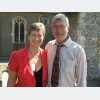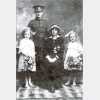| Profile | Posted by | Options | Post Date |

|
RStar
|
Report
|
1 Dec 2007 15:32 |
|
Nudge for future ref.
|

|
Lallie
|
Report
|
1 Dec 2007 20:38 |
|
Thanks very much
x
|

|
Joy
|
Report
|
23 Feb 2008 10:34 |
|
nudged
for Jeanette
|

|
Judith Jaybee
|
Report
|
20 Apr 2008 09:02 |
|
Light reading for a Sunday
|

|
Stacey
|
Report
|
20 May 2008 21:09 |
|
Thanks for nudging Joy. I would not of found it otherwise.
Staceyx
|

|
Joy
|
Report
|
26 May 2008 21:07 |
|
You're welcome
|

|
Joy
|
Report
|
4 Jun 2008 22:56 |
|
for Misty
|

|
Joy
|
Report
|
18 Aug 2008 15:34 |
|
nudged
|

|
Lady Cutie
|
Report
|
18 Aug 2008 18:20 |
|
Thanks Joy ,
just seen your thread
Hazelx
|

|
Joy
|
Report
|
21 Aug 2008 19:50 |
|
You're welcome.
|

|
Joy
|
Report
|
15 Jan 2009 20:15 |
|
The site
http://www.1911census.co.uk/
gives information as to what is on line.
http://blog.1911census.co.uk/
http://www.1911census.org.uk/
The latest census available to the public is the eagerly awaited 1911 census. In recent years, census information has been closed, certainly for family history purposes, for 100 years. The National Archives were planning to make the 1911 census available in January 2012 but a ruling by the Information Commissioner in December 2006 meant that the National Archives was forced to make the information available now. For practical reasons, all that was immediately available was a paid for search by National Archives staff to give the details of people living at a nominated address but this has now changed.
In April 2007, the National Archives announced that brightsolid would be their partner in the project to put the 1911 census for England and Wales online. As from 13th January 2009, it is available from brightsolid's genealogy subsidiary Findmypast on a dedicated website, with a phased release, county by county; this will include images and transcription data, initially on a pay-per-view basis only.
A caveat on this is that "personally sensistive" information will not be available until 3 January 2012. This includes "details of infirmity or other health-related information, information about family relationships which would usually have been kept secret and information about very young children who were born in prison".
The 1911 Census
The 1911 census was a household census taken on the night of Sunday 2nd April 1911. It holds information on every household, vessel, institution and overseas residencies that were part of England and Wales in 1911 (including some ships at sea, and some army units stationed overseas). A full entry would contain names of persons in each household, age, occupation, position in household (i.e. head, wife, son, grandfather etc), whether they had any illnesses and the full address of the property where they were residing that night.
The 1911 census is the first census where the householder's schedule has remained the master entry, rather than the enumerator's notes, so you will be able in most cases to view your ancestors' handwriting when looking at 1911 census entries.
The Householder and Institutional Schedules (National Archives document reference RG 14) contains 35,000 volumes detailing information relating to 35 million people in England and Wales. There are (approximately) 8,500,000 pieces of paper each slightly larger than an A3 sheet that make up the schedules, filled in by each head of household or similar authority. There are also 38,000 volumes of enumerators' summary books (document reference RG 78) to accompany the census. They hold useful and unique information that supports the census information but they do not provide the level of personal details that can be found in the census schedules.
The 1911 census sustained water damage many years ago, before it was transferred to The National Archives. This damage affected about 5% of the volumes and means that information is not retrievable from parts of these volumes. There is only one volume missing from the whole series in total.
Census Details
The details recorded for each person were:
Name and surname
Relationship to head of family
Age - this was recorded in separate columns for male and female
Marital condition
Number of years married (present marriage, question only answered by married women)
Number of children born to present marriage, number that are still living, number who have died. (again present marriage, married women only)
Personal occupation
Industry/service with which worker is connected
Employment status
Birthplace
Nationality (if born in a foreign country)
Infirmity, one of deaf, dumb, blind, lunatic, imbecile or feeble minded. The age at which the "infirmity came on" was also required. This information is considered personally sensitive and will not be available until 2012.
New information in the 1911 census was concerned with the family, that is the questions that had to be answered by married women on how long they had been married and how many children there were from the marriage. An article in The Times in January 1911 on the coming census said that "no such inquiry had been made at any previous Census, but its bearing on much-debated problems of national progress and retrogression is clear"
Also extra information was required on professions or trade rather than simply "occupation" as asked in the previous census. The two pieces of information required, "Industry/service with which worker is connected" and "Employment status", would mean for example that someone who was unemployed at the time of the census would still give his or her usual occupation.
|

|
Joy
|
Report
|
15 Jan 2009 20:24 |
|
.... continued
Organising the Census
Very precise instructions were given to try and ensure every one was counted once and only once. The rule was that someone should be included if they passed the night of Sunday April 2 1911 in this dwelling and were alive at midnight or arrived at the dwelling the following morning not having been enumerated elsewhere - intended to catch night workers. This did not include new-born children - anyone born after midnight should not have been enumerated.
Caravans and tents that were occupied on census night were counted as an inhabited dwelling. It was the job of the police to enumerate everyone who passed the night in "barns, outhouses or in the open air". To try and reduce the number of vagrants on the street, the Salvation Army opened up extra shelters for the night.
The Times reported the day after the census that the King and Queen had set an excellent example in "the careful and accurate filling-up of the census schedules" although their personal involvement appears to have been limited to telling palace staff to do the work, carefully and accurately.
It was the job of the 36,000 enumerators, mainly men, to distribute and then collect on Monday April 3rd the completed census schedules. They were paid a minimum fee of 21s plus 3s6d for every 100 persons enumerated after the first 400 as well as an allowance of 1s for every mile in excess of six "necessarily traversed in collecting the schedules". As well as distributing, collecting and checking the schedules, they also had to provide a summary of the dwellings and population in each enumeration district but they were spared the laborious work required in earlier censuses of copying schedules into the enumeration book.
Many of the enumerators worked for Boards of Guardians or other local authorities. There was concern before the census that if the headmaster of a primary school was absent doing his enumerator's duties, he would be at a disadvantage if the school were to be visited by an inspector, so inspectors were told not to choose that day to visit the school.
Failure to complete the census schedule was an offence, liable to a fine not exceeeding five pounds. The Suffragists campaign was in full flow at the time of the census and they planned to disrupt the census by staying out all night and refusing to complete a schedule. One group spent the night at a skating rink in Aldwych but they were counted there by the police so their action was considered a failure. The lack of names, age etc were seen as of secondary importance at the time although that will not be of much comfort to anyone trying to find details of suffragettes for their family tree.
Counting the Census
Once the enumerator's tasks were completed, the details were sent to a building in Millbank behind the Tate Gallery. Twenty-four calculating machines had been hired and installed there in preparation and details from the census were entered on to punched cards, one set of about 80 thousand for dwellings, a second set of about 4 million for married women and a third set of about 36 million for the rest of the population. The cards were punched to contain key information from the schedules and then sorting machines read the cards and sorted them.
The Times described how the "machines are worked and the division is accomplished by electricity. The cards pass between a wire brush and a brass roller. The wires on the brush press against one column of the card and, passing through the punched aperture in that column, establish electric contact with the roller at a spot opposite the aperture and corresponding to the particular class which the punched mark represents. A corresponding "jaw" immediately opens, the card slips into it, and is forced into one of 11 boxes representing as many classes".
All this was intended to produce the census results within a year. Provisional figures were produced on May 25th that year showing the population of England and Wales as 36 million, an increase of 10.9% since 1901.
|

|
Joy
|
Report
|
17 Jan 2009 18:30 |
|
A reply received from National Archives; I had asked if or when the ancestry site would have the 1911 census.
The 1911 Census contract was awarded to
Scotland Online (brightsolid) who subsequently acquired Find My Past.
No microfilm exists of the 1911 census, in contrast to previous censuses
which had previously been filmed. Scanning from original paper documents
is about 10 times more costly than scanning from microfilm. The huge
investment involved in scanning 18m images in colour direct from paper
original census returns has to be recouped if digitisation is to be
economically viable, thus The National Archives agreed that for the
initial launch period of this census, pricing would be on a pay-per-view
basis only. Scanning is still ongoing, so there will be a phased release
of records over a few of months in 2009. Later in the year, these
records will be incorporated into findmypast subscription content, and
available on the same terms as other censuses, passenger lists and other
genealogical resources.
In addition, once the scanning and transcribing of the 1911 census has
been completed and has been available online for 6 months, the images
only, will be available for duplication and re-sale to any other
commercial providers, county record offices or any other interested
bodies or individuals, who will then need to create their own
transcriptions, indexes and online services, but we have not entered
into any formal negotiations with secondary licensees at this point in
time.
|

|
Joy
|
Report
|
23 Jan 2009 15:05 |
|
- for Suzanne
|

|
Joy
|
Report
|
23 Jan 2009 15:50 |
|
http://blog.1911census.co.uk/2008/12/the-order-of-scanning-and-our-unintentional-northsouth-divide/
We’ve received many comments on this blog and through the surveys expressing disappointment at the lack of northern English and Welsh counties during the beta period. We’d like to reassure you that this is not intentional!
We’ve been scanning and transcribing the census in order of National Archives catalogue piece number. Broadly, this was originally dictated by the civil servants of the time who ordered the numbering system so that it started in London, moving outwards and upwards through the English counties, then the Welsh counties, and finally the islands and military establishments. This is the order in which the records will be released on 1911census.co.uk in 2009.
Incidentally, the original documents are also stored in this order at the National Archives, so we have been working our way through the two kilometres (or one and a quarter miles in old money) of shelving that these records take up. The records take an enormous amount of time to prepare using hundreds of staff – the 1911 census is eight times larger than previous censuses as it is the only census to date where the household schedules have been preserved. We still have a long way to go until scanning is complete – we will continue to work at The National Archives well into 2009 to finish the image scanning and we then still have the job of transcribing the remainder of the census.
Unfortunately the early timing of the beta test means that the counties available are inevitably concentrated in the south, but we wanted to be able to test the site as early as possible with a reasonable number of records available.
The counties available during beta is restricted to those for which all pieces have been fully scanned and transcribed and which have had personal details redacted (removed) from the images. This is the reason that some southern counties are still not available – we are still in the process of redacting the images or completing the entire county. They have also been selected to give a good balance of urban and rural counties in order to test the address search functionality.
Our policy is to release only complete counties (as defined by The National Archives catalogue for boundaries) to avoid confusion .
Inevitably, in a project of this size some counties have to come later than others, unless we’d taken the rather cruel decision to wait until absolutely everything was complete before letting people take a look, but this would have been contrary to the spirit of the Information Commissioner’s ruling that the records should be made available as soon as possible. Everyone should be satisfied in 2009, rather than having to wait until the original opening date of January 2012.
|

|
Cheryl
|
Report
|
31 Jan 2009 14:52 |
|
Wonderful, thanks so much for your time and sharing of information.
Cheryl
|

|
Joy
|
Report
|
31 Jan 2009 15:37 |
|
You're welcome.
|

|
Sally
|
Report
|
1 Feb 2009 00:04 |
|
thanks for all that great info
sally
|

|
Joy
|
Report
|
3 Feb 2009 16:53 |
|
You're welcome.
|

|
Joy
|
Report
|
6 Feb 2009 22:43 |
|
http://blog.1911census.co.uk/2009/02/
Friday, February 6th, 2009
We thought we’d give you an update on the remaining counties and approximately when they will appear on the site. Please note that the dates are highly approximate, but we prefer to give you a rough guide rather than a firm date that we might miss. Please don’t plan your holidays around them…
The list below is the order of scanning the documents: this might not necessarily be the order the counties actually appear on the site but it should be reasonably close.
The remaining English counties should all be available on the site within two months - the best indication we can give for Wales, Islands and Military at present is summer 2009 but we hope this is more useful than saying nothing! As soon as we can give a closer indication on specific counties and a better steer on Wales, we will.
Order of scanning:
Yorkshire, East Riding (with York)
Yorkshire, North Riding
Durham
Northumberland
Cumberland
Westmorland
Monmouthshire
Glamorganshire
Carmarthenshire
Pembrokeshire
Cardiganshire
Brecknockshire
Radnorshire
Montgomeryshire
Flintshire
Denbighshire
Merionethshire
Carnarvonshire
Anglesey
Isle of Man
Guernsey
Jersey
Alderney
Sark
Royal Navy
Military
|

